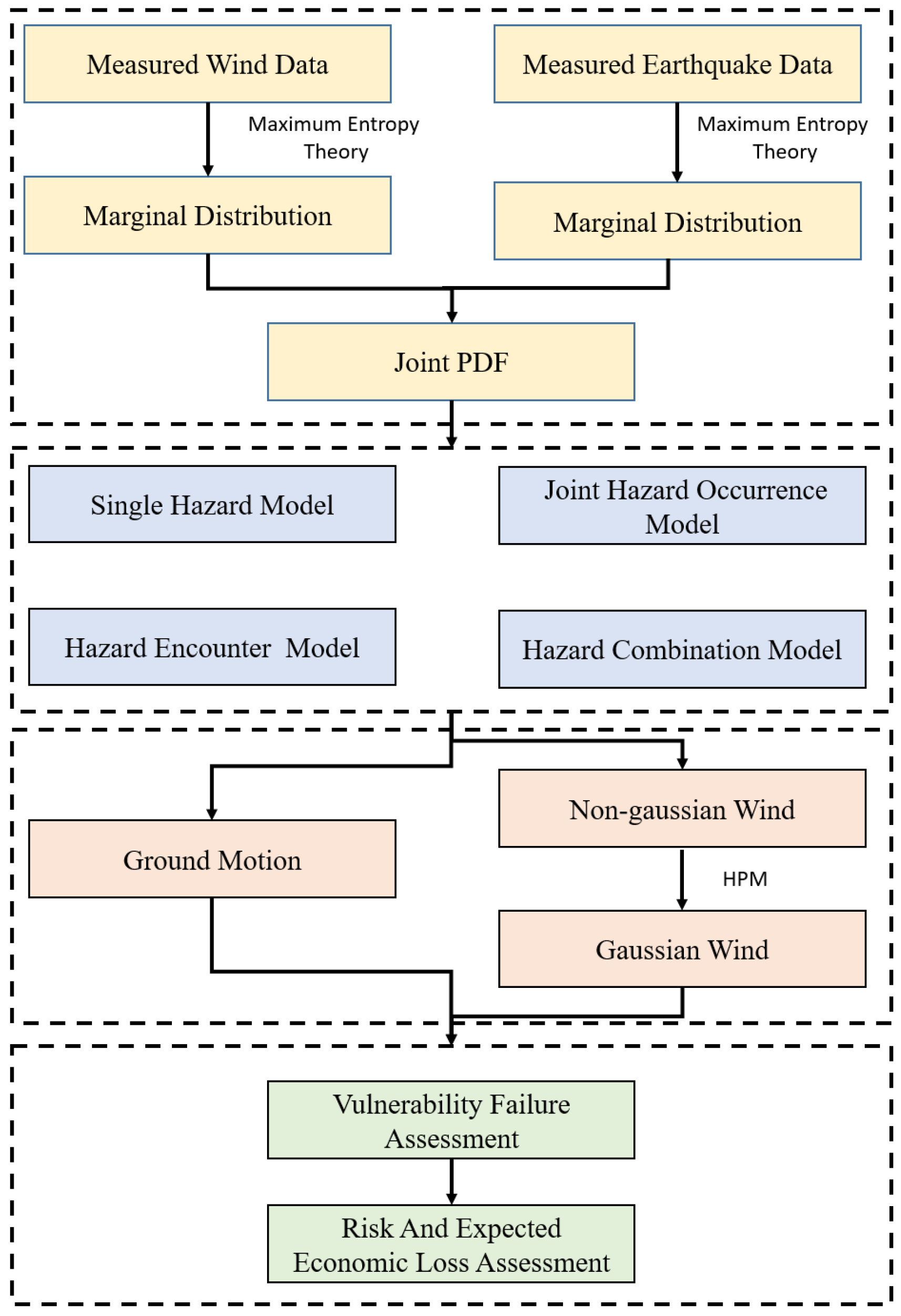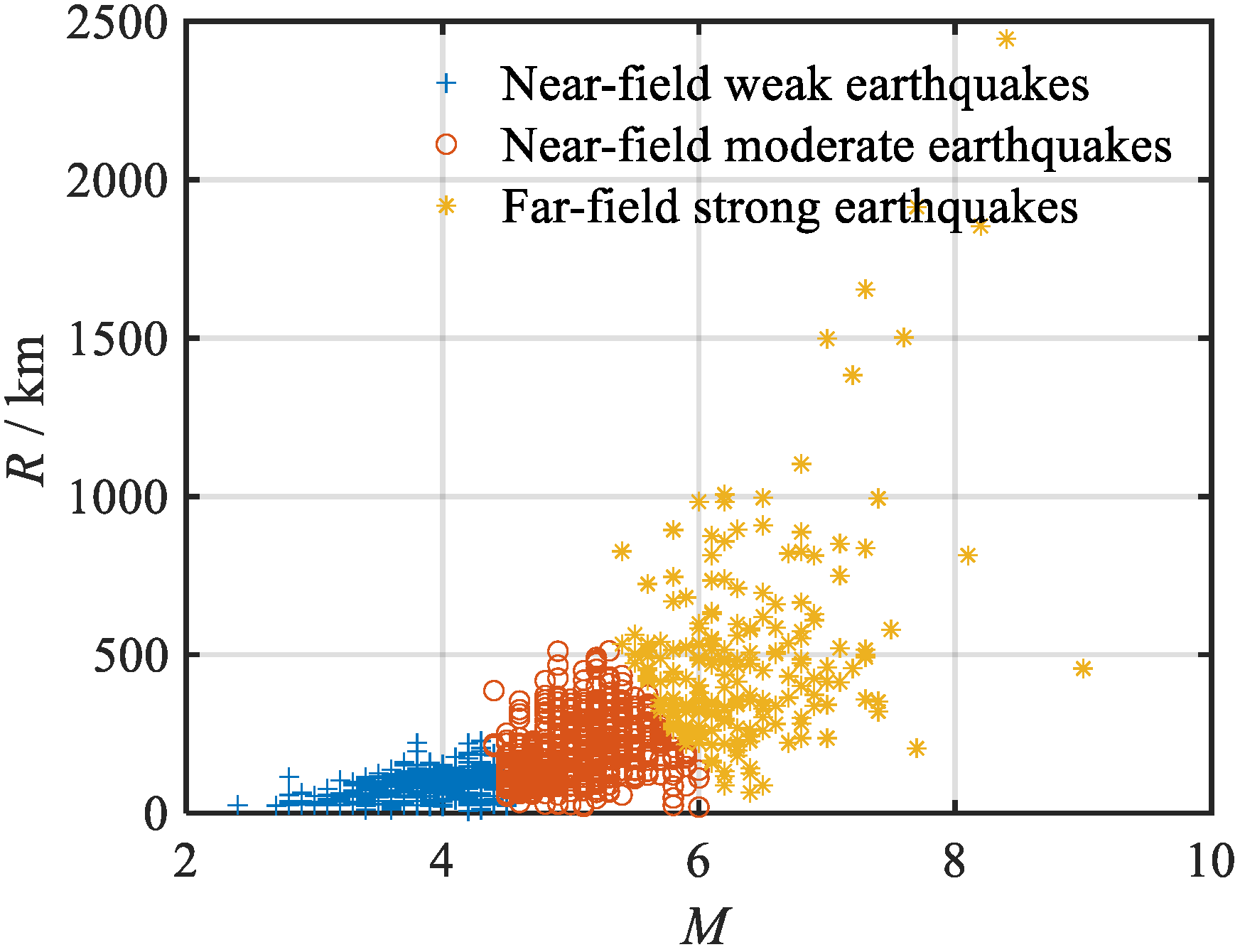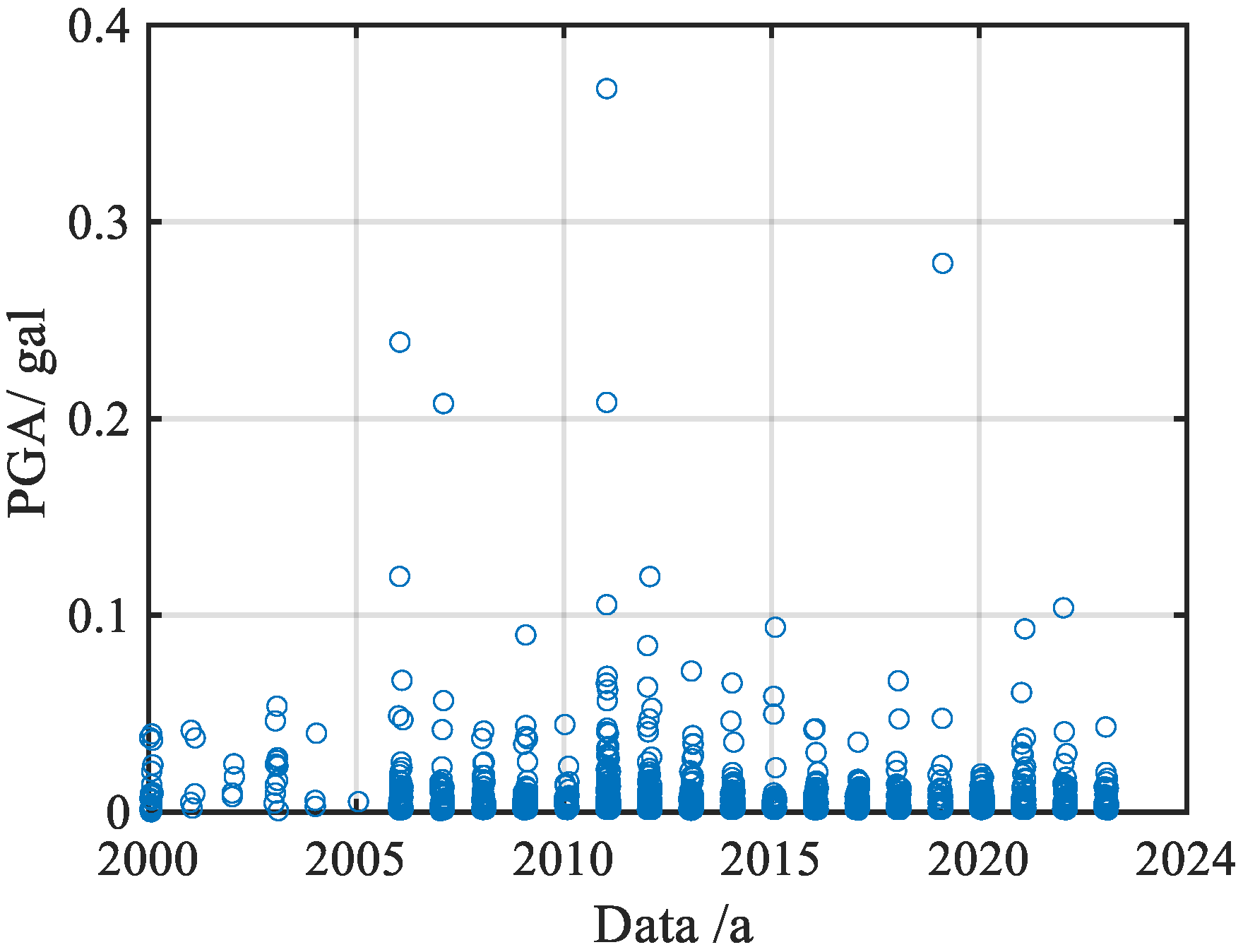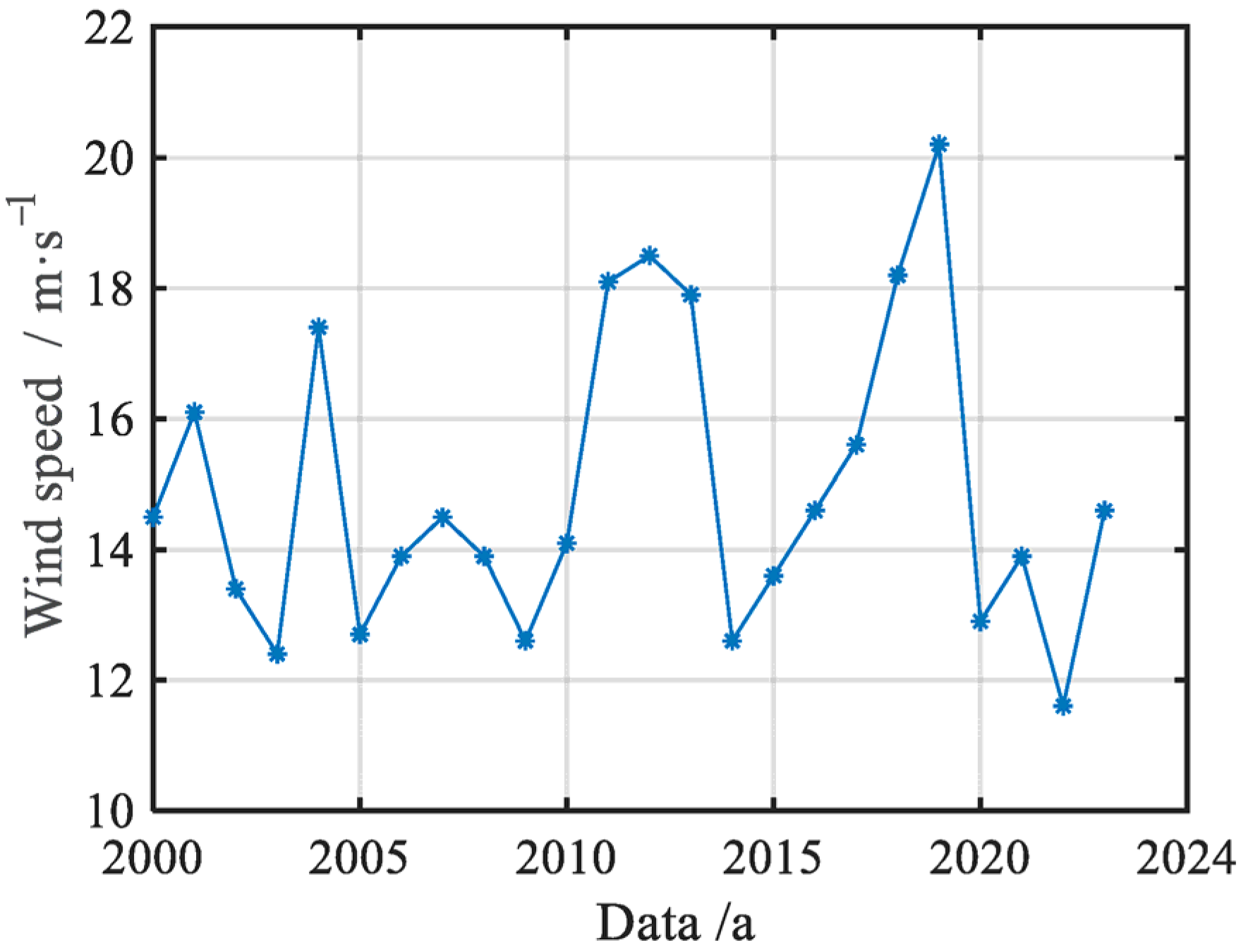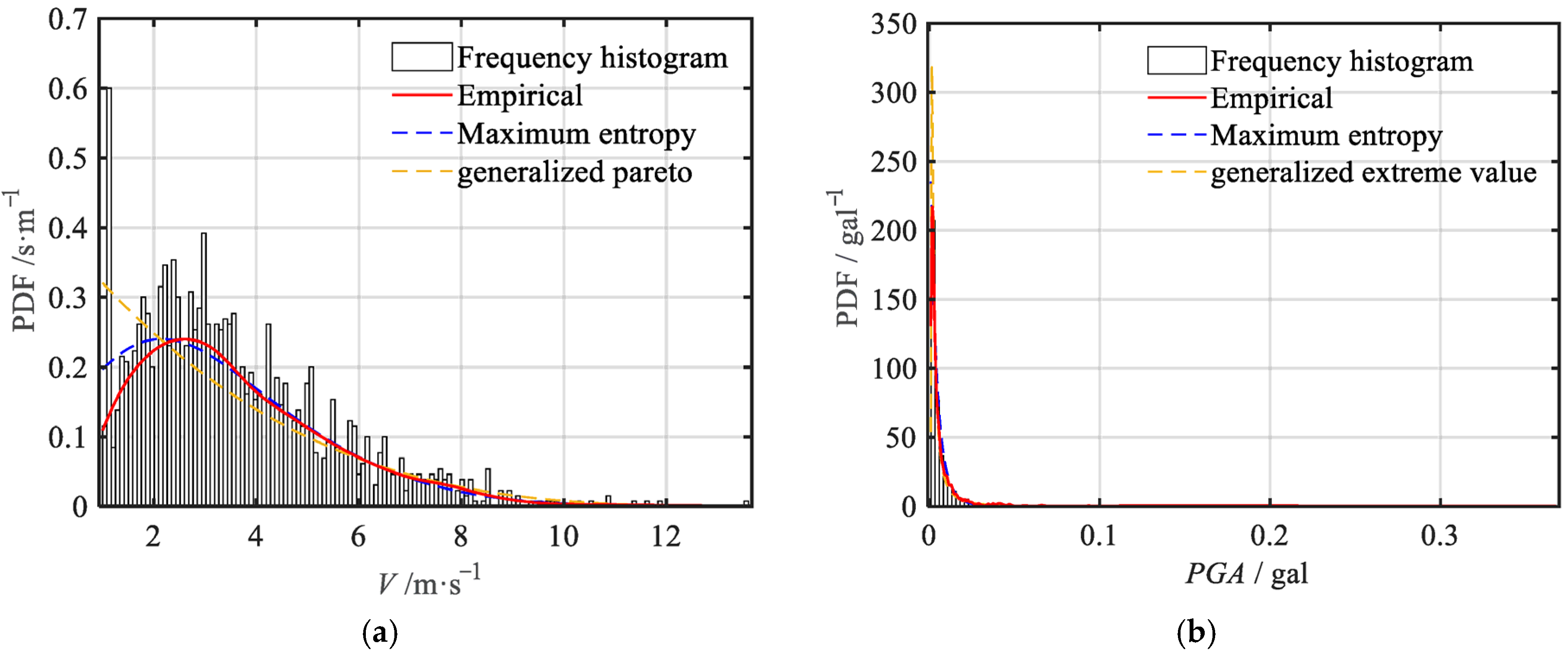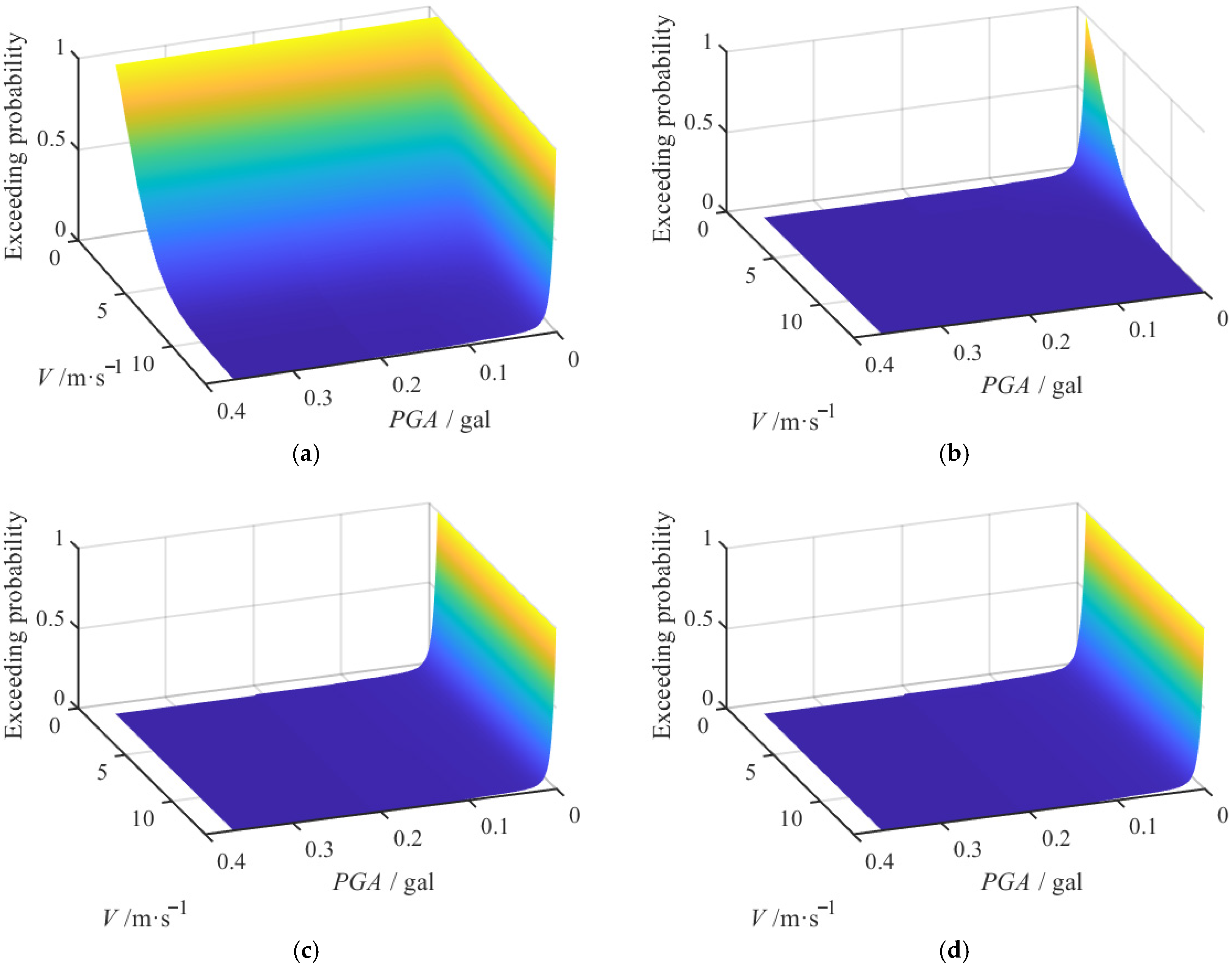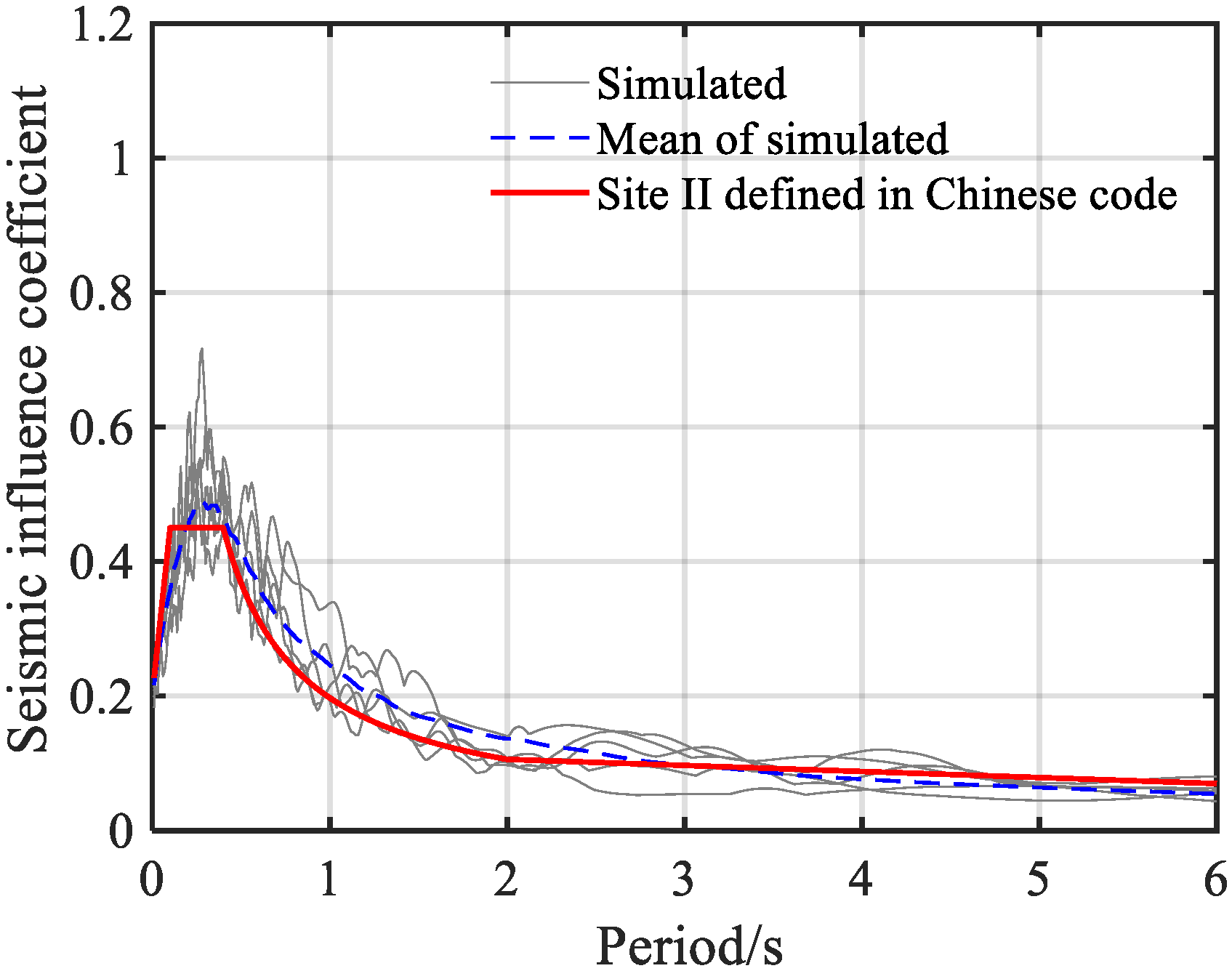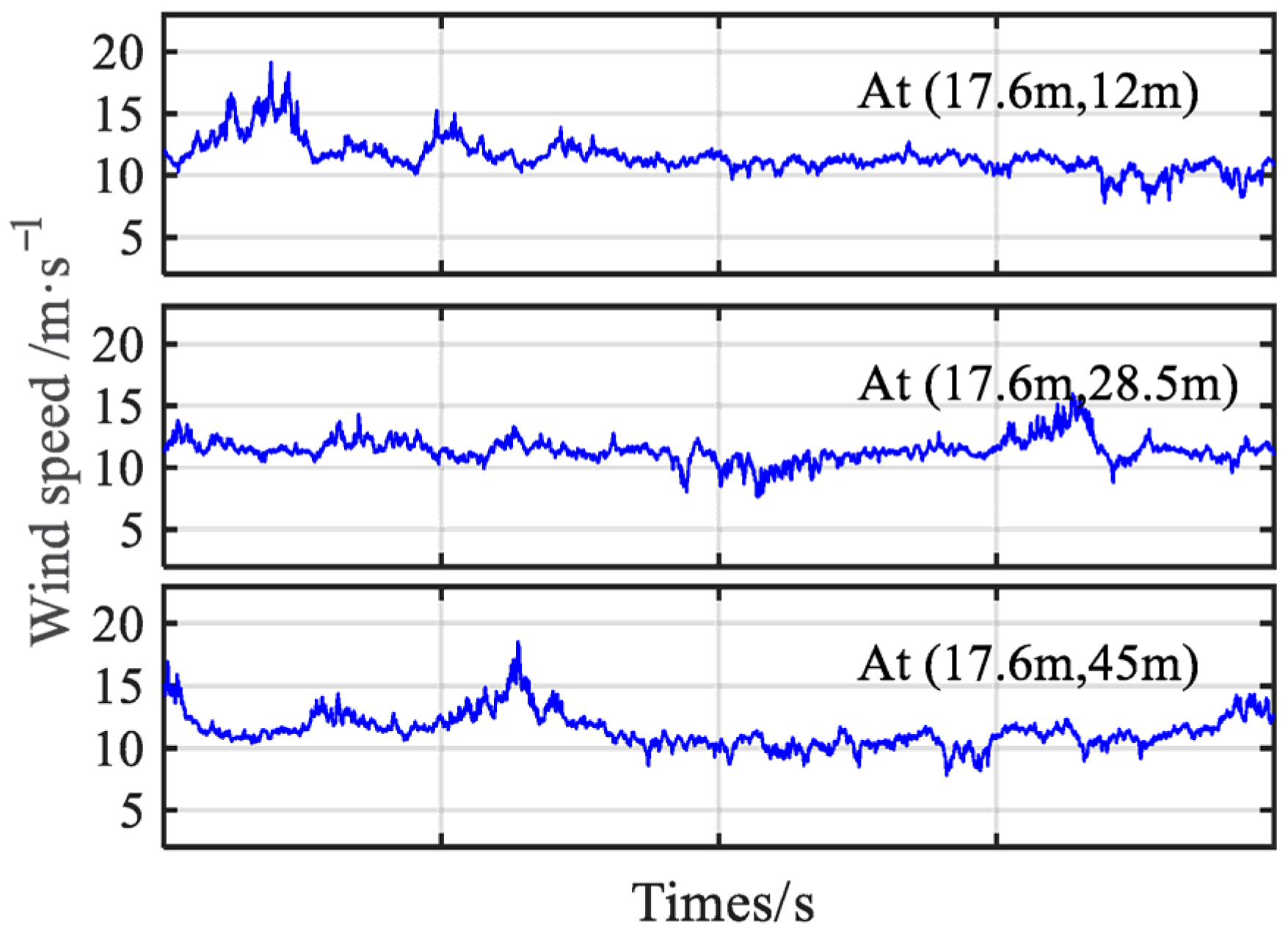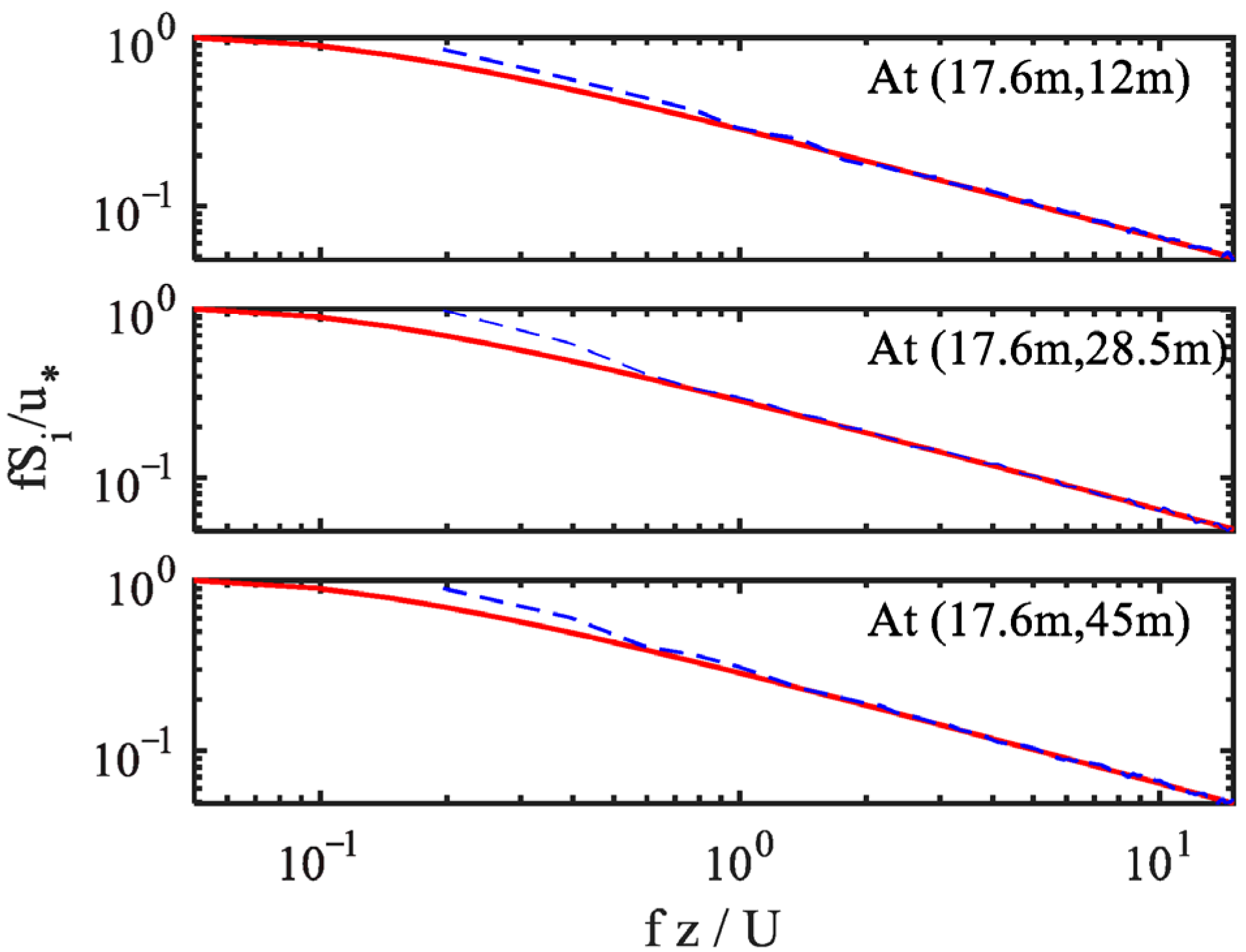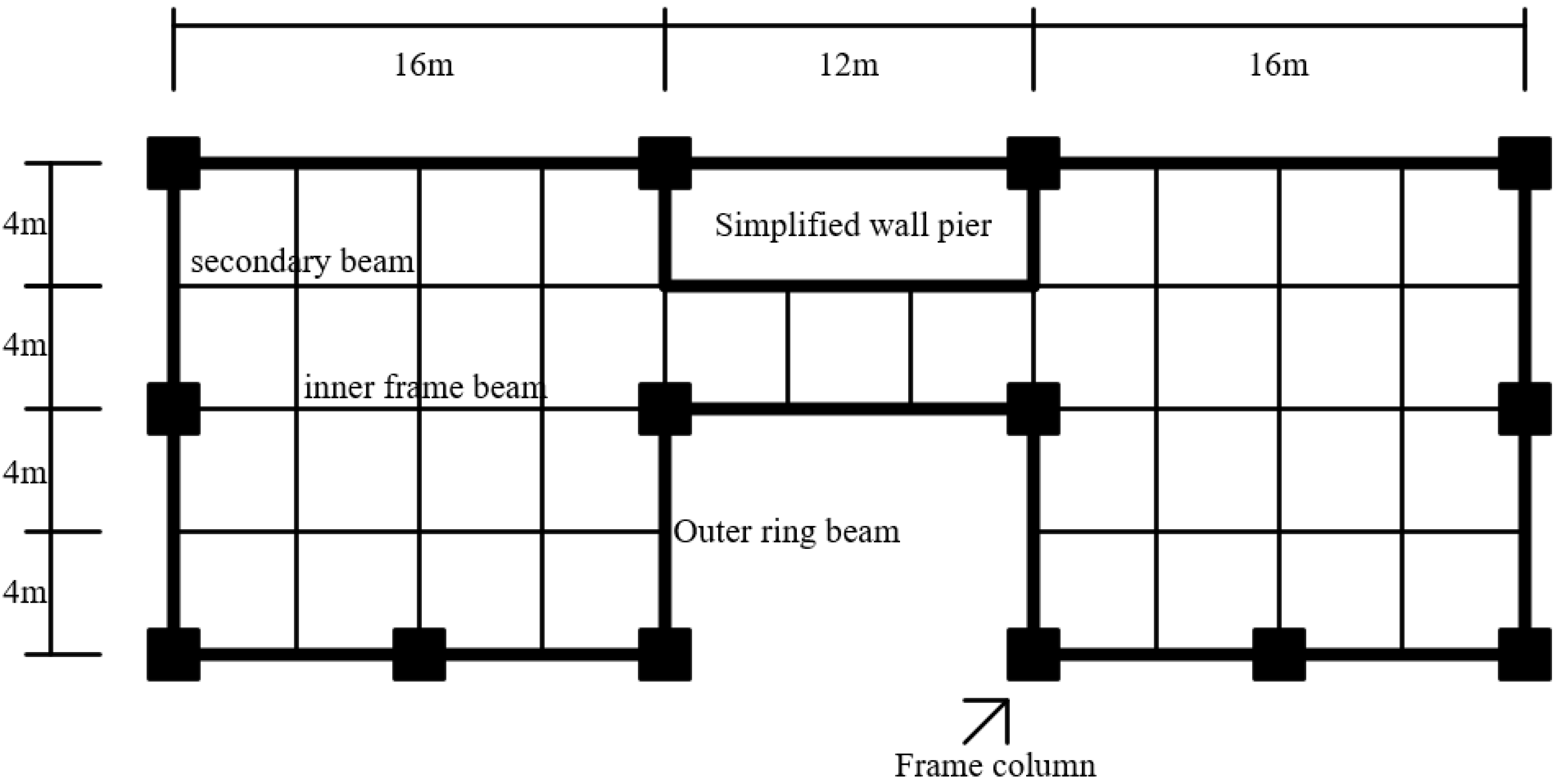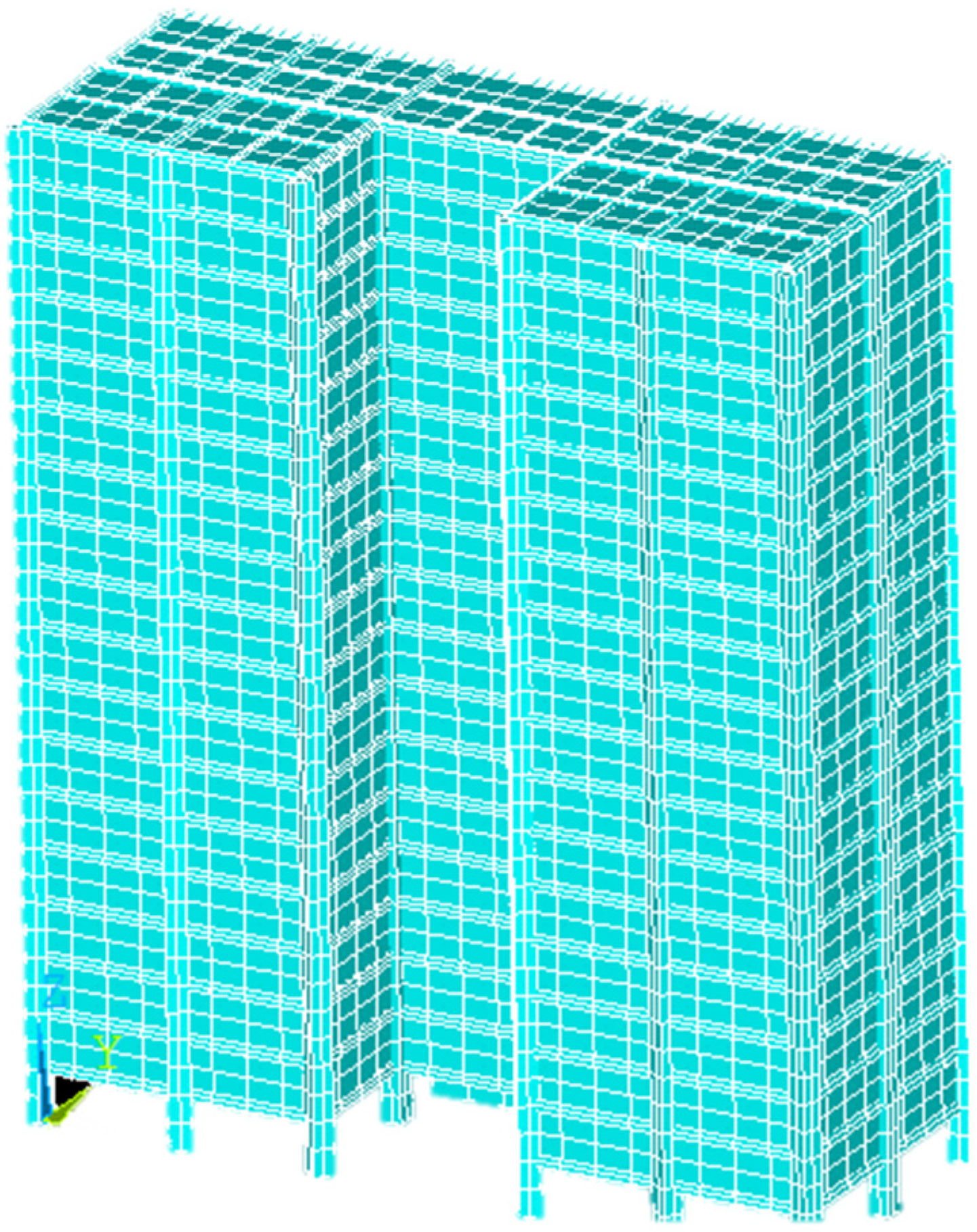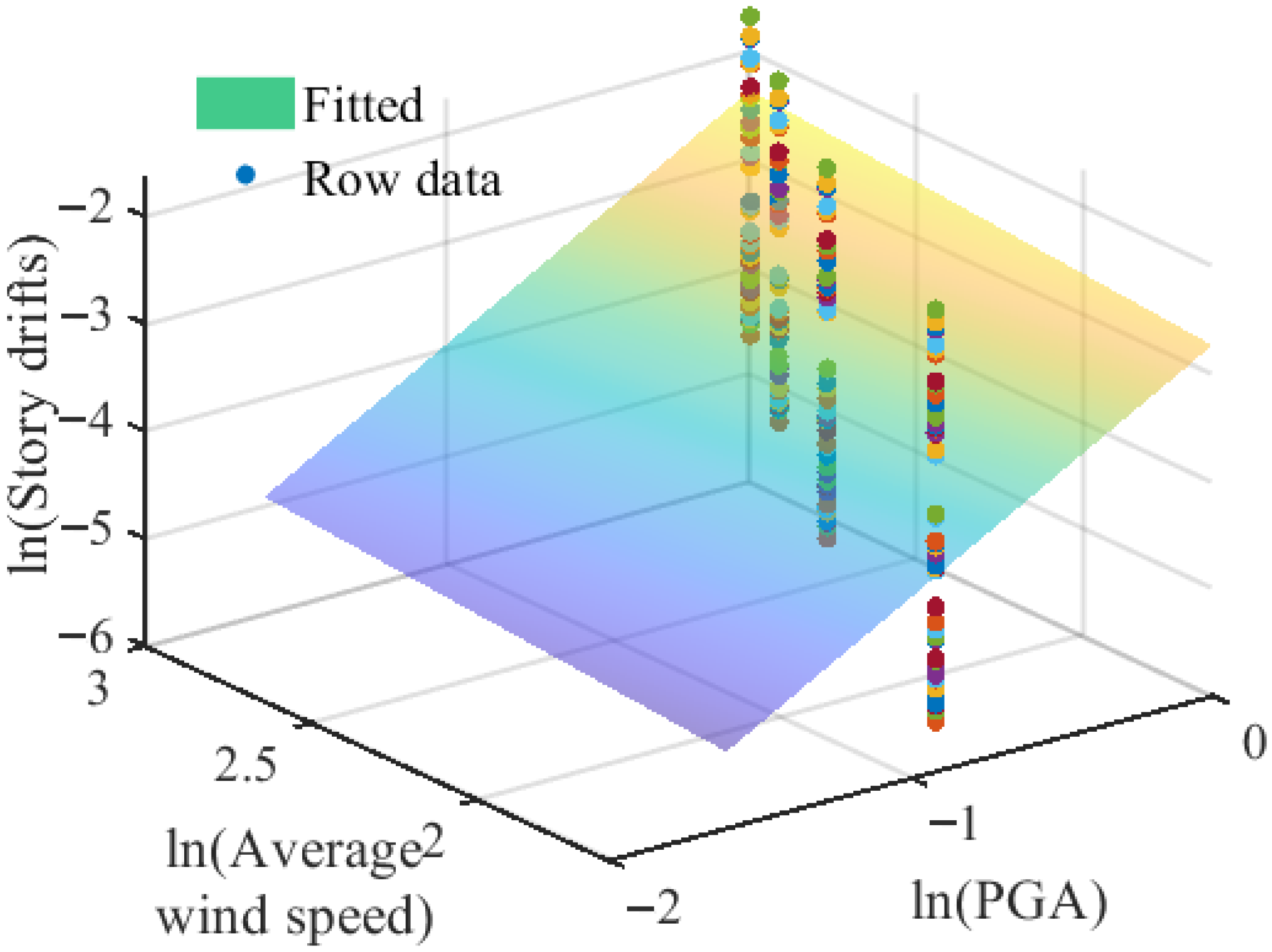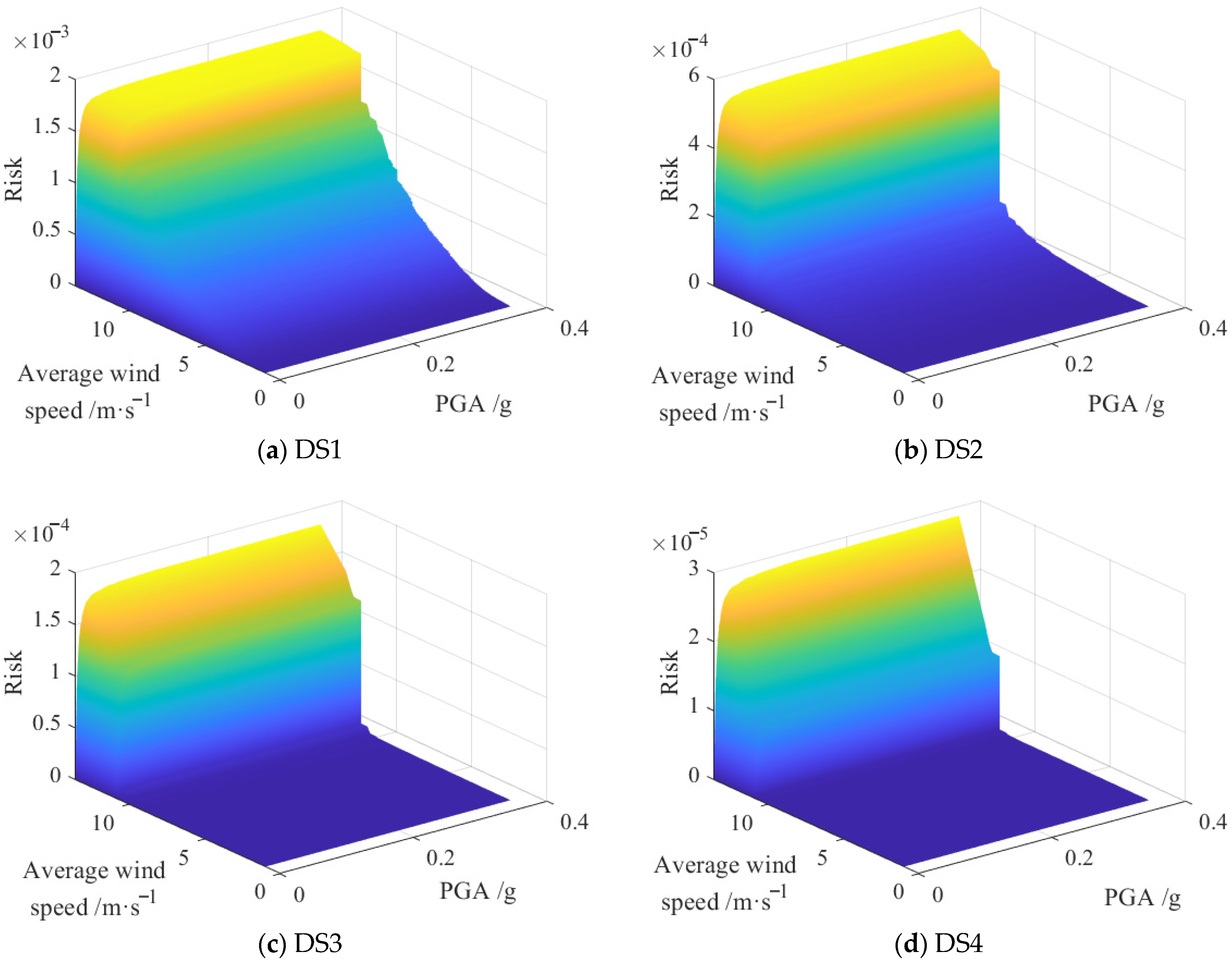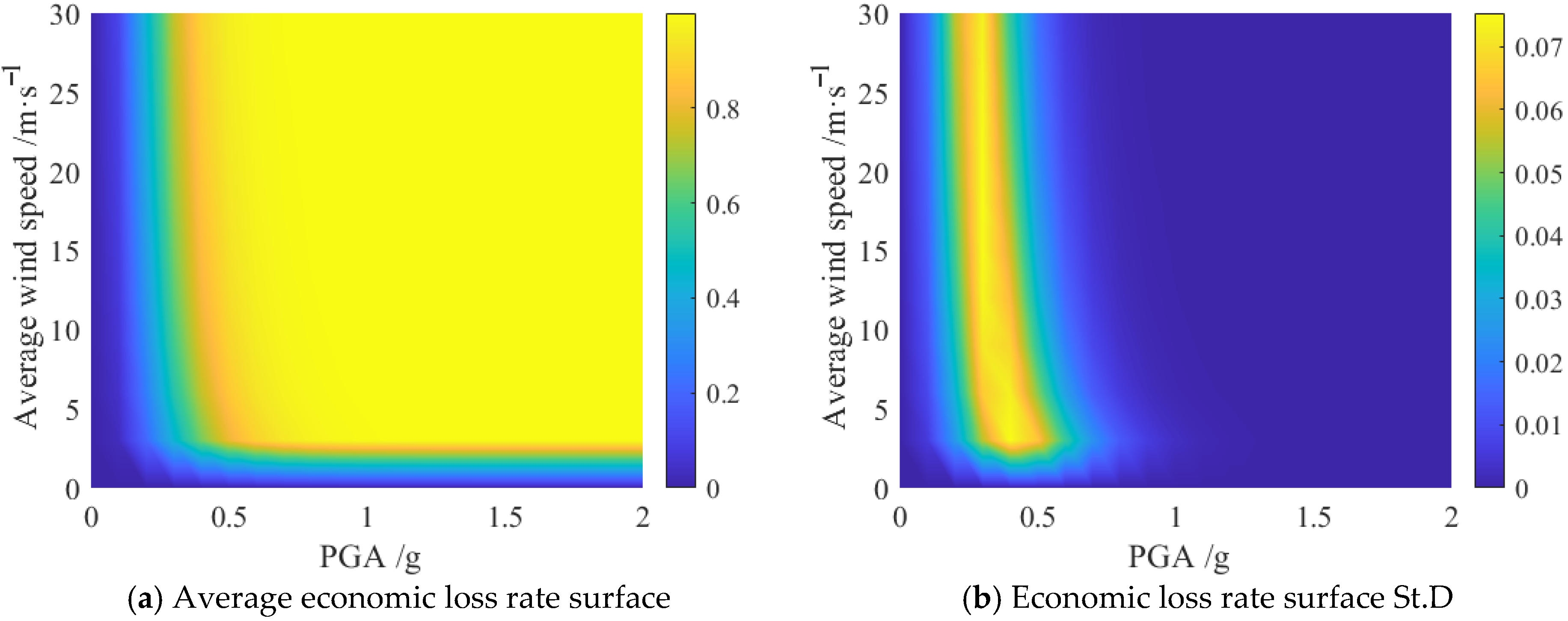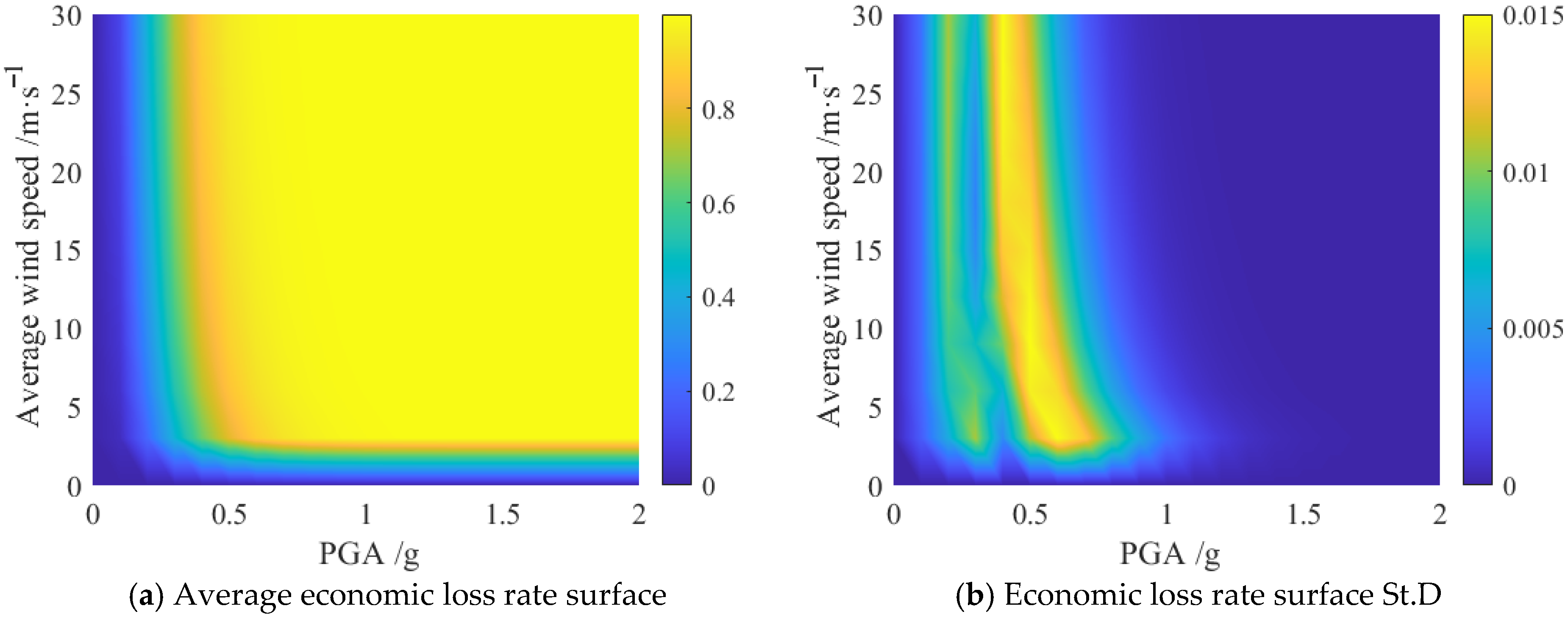1. Introduction
Coastal structures, due to their unique geographic location and surrounding environment, face complex and severe threats from natural disasters. Coastal areas not only experience frequent seismic activity but are also often impacted by extreme weather events, such as strong winds, storms, and hurricanes. This combination of geographic and climatic conditions necessitates that coastal buildings address various complex environmental loads during both design and usage to ensure structural safety and reliability [
1]. In today’s context of increasingly frequent and compounding natural hazards, robust multi-hazard risk modeling [
2,
3] and accurate economic loss estimation under uncertainty [
4,
5] are not only vital for understanding individual hazard impacts but are also critical for capturing the interdependencies and cascading effects that can arise during compound events. These analytical approaches allow for the development of quantitative resilience metrics, probabilistic risk assessments, and adaptive design strategies that collectively support the long-term functionality and reliability of coastal infrastructure systems [
6,
7].
Wind and earthquakes, as the two main natural disasters, have particularly significant impacts on coastal structures. Individual wind loads or seismic loads can cause severe damage, while their combined effects increase the likelihood of catastrophic structural failures. For instance, in 2021, several notable events illustrated the combined impact of wind and seismic hazards. On 18 April, Typhoon “Surigae” reached its peak intensity, and, shortly after, Hualien County in Taiwan experienced consecutive earthquakes of magnitude 5.6 and 6.1. On 13 June, before Typhoon “Chanhom” made landfall in Thanh Hoa Province, Vietnam, Yunnan Province in China was struck by two earthquakes with magnitudes greater than 5.0. Furthermore, from 4 to 6 August, Typhoon “Lu Bi” passed through China’s southeastern coastal regions, during which Taiwan experienced three earthquakes with magnitudes greater than 5.1. These instances highlight how coastal structures are at risk from both seismic and wind hazards occurring in close succession or simultaneously. Therefore, conducting in-depth research on the combined characteristics of wind and earthquakes, their return periods, and assessing the associated risks and expected economic losses for coastal structures is crucial for accurately evaluating the threats faced by these buildings under extreme conditions, and for formulating effective design and protective measures [
8].
Reinforced concrete (RC) structures, known for their high strength, durability, and ease of construction, have seen widespread application in civil engineering in recent years. With continuous advancements in construction technology, RC structures are increasingly used in high-rise buildings, bridges, and various infrastructure projects. In recent years, with rapid developments in material science and structural analysis techniques, the design and construction methods of RC structures have been significantly improved. Especially under the combined effects of seismic, wind, and other multi-hazard loads, the performance of RC structures has been further enhanced, with innovative technologies increasingly applied to improve their disaster resistance and structural safety. This has made RC structures a crucial choice in modern construction, ideal for addressing complex engineering challenges [
9,
10,
11,
12,
13]. Currently, the mechanisms and disaster processes affecting civil engineering structures under the dual impacts of seismic and strong wind forces have been a focal point of research within the civil engineering community, yielding systematic results. For instance, Vanessa [
14] established a unified model for wind turbines under realistic sea conditions, using this model to evaluate the structural performance of offshore wind turbine structures—such as drift ratios, normalized base shear, and operational stability—under wind and seismic loads. Mensah [
15] developed a model of offshore wind turbines considering aerodynamic and elastic characteristics, investigating the dynamic responses of this model under stochastic wind loads and recorded seismic events. Venanzi et al. [
16,
17] examined the dynamic responses of high-rise buildings under the combined effects of earthquakes and multiple hazards, proposing a comprehensive framework for lifetime loss assessment and life-cycle cost analysis under multi-hazard scenarios. Dogruel [
18] suggested a multi-hazard optimization design and reinforcement method for building structures under combined seismic and wind loads based on lifetime cost indicators. The study by Athanasiou [
19] proposes an improved multi-hazard design method for tall steel buildings in Eastern Canada, introducing a wind-related reduction factor (RW) to optimize structural performance under combined wind and earthquake effects, while verifying its impact on design response and collapse capacity. The work by Ciabatton [
20] focuses on design trade-offs for tall buildings subjected to wind and earthquake loading, proposing a multi-hazard approach that integrates low-damage steel-timber systems and employs an Acceleration Displacement Response Spectrum (ADRS) to compare structural performance under these competing hazards, validated through case studies of 18- and 36-story buildings.
Existing research has pointed out that earthquakes and wind can mutually influence each other. For example, strong winds may trigger microseismic events and slow earthquakes, while typhoons can induce regular earthquakes, etc. For instance, Lin [
21] found, through a study on the potential correlation between 102 typhoons passing near or traversing Taiwan from 1995 to 2011 and regular earthquakes, that the overall correlation was 63.75%. This correlation was particularly high after the 1999 Chi-Chi earthquake in Taiwan, where it increased from 16.67% to 78.21%. As a major earthquake, the Chi-Chi event significantly enhanced the previously low correlation between typhoons and seismic activity [
22,
23]. Additionally, earthquakes can also induce strong winds through mechanisms such as atmospheric temperature changes and electromagnetic wave anomalies. It is evident that there exists a potential nonlinear relationship between earthquakes and wind. Although considerable progress has been made in research on structural vulnerability under the joint influence of wind and earthquakes, there is a notable lack of studies focusing on the hazard analysis of these interactions, particularly regarding the patterns, probabilistic distribution characteristics, and joint return levels of multi-hazard events in coastal areas. This oversight not only results in an incomplete understanding of how coastal buildings withstand disasters but also hampers the development of effective optimization designs and disaster mitigation measures tailored to these structures [
24,
25]. By primarily focusing on vulnerability studies and neglecting the critical aspects of hazard analysis, the potential impacts of extreme weather and seismic events may be underestimated. This could lead to inadequate preparedness, increased economic losses, and compromised safety for occupants [
26,
27]. Therefore, conducting comprehensive risk assessments for coastal buildings that integrate real-world data and advanced statistical models is essential, as it would enhance the resilience of structures and inform better engineering practices and policy decisions, ultimately safeguarding communities against multi-hazard threats.
Moreover, in coastal regions, the seismic intensity characteristics in coastal areas can differ markedly from those inland, influenced by geological factors and proximity to fault lines [
28,
29]. Additionally, coastal winds often exhibit non-Gaussian behavior, which can lead to more extreme and unpredictable loading conditions compared to traditional Gaussian wind models. This non-Gaussian nature can result in higher peak wind forces and increased susceptibility to dynamic responses in structures, potentially exacerbating damage during extreme events [
30,
31,
32,
33]. Neglecting these distinct wind characteristics impedes a thorough evaluation of coastal buildings’ disaster resilience and limits the effectiveness of design strategies and mitigation measures. The lack of comprehensive risk analysis may lead to significant vulnerabilities, resulting in catastrophic consequences during storms or seismic events. Therefore, it is imperative to conduct robust risk assessments that incorporate actual data and sophisticated statistical models, enhancing the understanding of multi-hazard dynamics and improving the safety and resilience of coastal structures to better protect communities from potential disasters.
The core methodology of this study involves integrating various advanced statistical and theoretical models to comprehensively analyze the joint risk of wind and earthquakes. Specifically, this paper first collects observed offshore seismic motion data and time-averaged wind speed data from the KIK Seismic Station and the Japan Meteorological Agency since 2000, ensuring they share the same temporal and spatial characteristics. Next, peak acceleration and wind speed are constrained using the first six moments, and their marginal probability distributions are estimated through the maximum entropy model, ensuring precise capture of the data’s marginal characteristics. Subsequently, a joint probability distribution model of wind and earthquakes is constructed using Copula theory, revealing the dependence between the two. Finally, based on multi-hazard return period theory, four consistent hazard function models are employed to systematically analyze the joint exceedance probabilities and return periods of offshore earthquakes and strong winds under various scenarios. A coastal frame structure is selected as the engineering background, and its risk level and expected economic loss are assessed. In summary, this research systematically analyzes the risk characteristics of coastal buildings under the combined influence of wind and earthquakes, providing strong support for further structural safety research under multi-hazard conditions based on empirical data and statistical analysis. While our case study focuses on an 18-story coastal RC frame, the same probabilistic workflow—combining sixth-order moment marginal fitting, Copula-based joint hazard modeling, and multi-hazard fragility-loss surfaces—can be directly applied to other forms of structures, such as tunnel structures [
34,
35,
36]. The flowchart of the study has been shown in
Figure 1.
2. Source of Measured Data
The offshore seismic records used in this study were obtained from the KiK-Net strong motion database in Japan. This network comprises six closely spaced offshore stations dedicated to recording offshore seismic motion, as shown in
Table 1. Due to the proximity of these six stations, they recorded a substantial amount of redundant data, which is not particularly meaningful for this study. Therefore, only the KNG206 station’s horizontal seismic records from January 2000 to December 2023, totaling 1574 measurements, were selected for analysis. Additionally, the raw data from the KIK database has not undergone any preprocessing, necessitating a series of treatments, including high-pass filtering, baseline correction, and energy clipping between the 1% and 99% thresholds, to ensure the accuracy of the research findings.
Furthermore, since the KiK-Net database does not provide site-specific information for the offshore stations, this study will utilize the K-means clustering method, based on the moment magnitude and epicentral distance (R), to categorize the offshore strong motion records into three groups: far-field large earthquakes, near-field moderate earthquakes, and near-field small earthquakes. There is no far-field small earthquake category due to the inability of small earthquakes to propagate over long distances. The clustering results are illustrated in
Figure 2. It is evident that the grouping results from the clustering method bear similarities to the seismic classification outlined in the “Code for Seismic Design of Buildings” (GB 50011-2010) [
37], with each category containing a comparable number of earthquakes, thus demonstrating the broad applicability of this study. The specific classification results are detailed in
Table 2.
Figure 3 presents a scatter plot of the occurrence time of offshore earthquakes and their peak accelerations. It is evident that while the intensity of offshore earthquakes is generally low, their frequency of occurrence is high, demonstrating significant sequential patterns.
To ensure the reliability and consistency of the research results, this study obtained hourly average wind speed data from the Japan Meteorological Agency’s official website (
https://www.data.jma.go.jp, accessed on 3 June 2024) that aligns with the location and time frame of the KNG206 station. This meteorological station is located in Yokohama, Kanagawa Prefecture, Japan, specifically at a latitude of 35.26 and a longitude of 139.39.
Figure 4 presents a line chart of the annual extreme average wind speeds over 24 years. It is evident that the overall climate in this region is relatively stable, with few extreme events occurring. It is important to note that this study only selected wind speed data corresponding to the exact times of offshore earthquakes for analysis.
6. Conclusions
This study investigates the joint recurrence period of earthquake and wind hazards at a coastal site, assessing the vulnerability and economic impacts on a high-rise frame structure. The findings demonstrate that the integrated application of maximum entropy theory and Copula functions provides an effective approach for evaluating the hazard intensity and recurrence intervals of submarine earthquakes and strong wind events. For the PGA marginal distribution, our sixth-moment maximum-entropy model achieved an R2 of 0.90, compared with 0.57 for a conventional GEV fit—reflecting a 58% increase in explained variance. Among the various models considered, the co-occurrence model exhibits superior performance over encounter, combined, and single-hazard models. The analysis indicates that, under a 0.4 g ground motion and a simultaneous wind speed of 15 m/s, the probabilities of slight, moderate, severe, and collapse damage are approximately 2 × 10−3, 6 × 10−4, 2 × 10−4, and 3 × 10−5, respectively. Furthermore, both the randomness of structural parameters and the uncertainty of economic loss ratios are found to significantly influence the economic loss ratio, with the greatest variability—reaching up to 0.015—observed within the 0.2 g to 0.4 g seismic intensity range, where seismic action predominates.
The strengths of this article lie in its innovative integration of advanced probabilistic models and real-world hazard data to assess the compound risks facing coastal structures, as well as its clear quantification of both hazard and economic impacts. The use of joint probabilistic modeling and the consideration of multiple sources of uncertainty represent significant advances in multi-hazard risk assessment. However, the study could be further strengthened by incorporating more detailed modeling of earthquake frequency spectra, the nonlinear response of high-rise structures, and a broader analysis of material variability. Addressing these areas in future work will enhance the accuracy and applicability of the proposed framework for practical engineering design and disaster mitigation.
This study assumes a single wind direction and rigid foundation, neglecting wind-direction variability, multi-directional loading effects, and soil–structure interaction (SSI). It also lacks direct validation against field or experimental data and models only a regular frame without plan irregularities or core-wall systems. Future work will introduce multi-directional wind fields and SSI, calibrate the framework using measured and experimental results, and extend its application to tunnels, bridges, and other complex structural configurations. Despite these limitations, the proposed joint risk assessment workflow provides valuable guidance for design practice, code development, and emergency planning.
